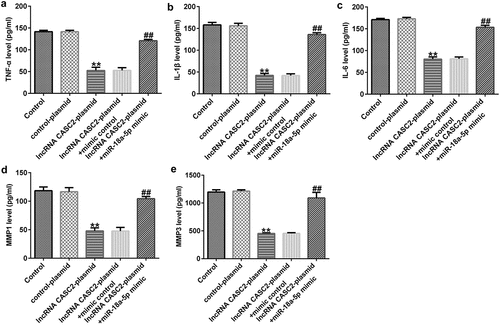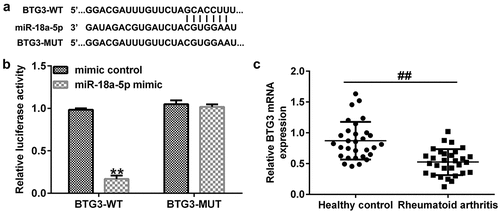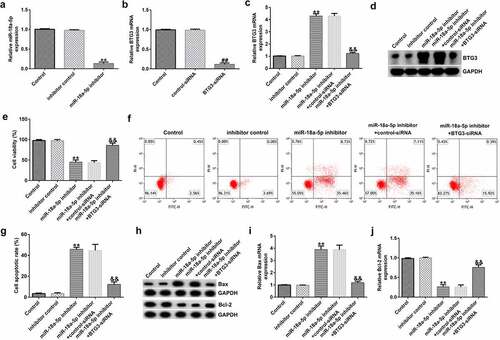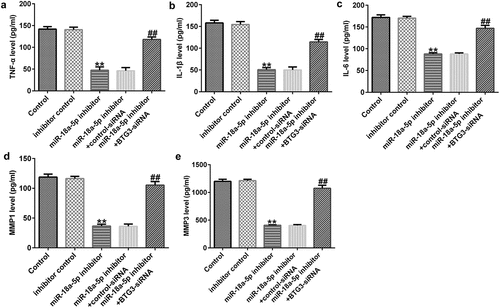Figures & data
Table 1. Clinical characteristics of RA patients
Figure 1. miR-18a-5p binds to the 3’UTR of lncRNA CASC2. (a) Prediction of a complementary lncRNA CASC2 and miR-18a-5p binding site. (b) Expression of miR-18a-5p in 293 T cells after mimic control or miR-18a-5p mimic transfection. (c) The Dual-luciferase reporter assay confirmed the relationship between lncRNA CASC2 and miR-18a-5p. **P < 0.01 vs. mimic control. miR, microRNA; lncRNA CASC2, long non-coding RNA cancer susceptibility candidate 2. Experiments were repeated for three times.

Figure 2. Level of lncRNA CASC2 and miR-18a-5p in the sera of patients with RA and healthy volunteers. Reverse transcription-quantitative PCR analysis of (a) lncRNA CASC2 and (b) miR-18a-5p levels in the sera of patients with RA and healthy volunteers. **P < 0.01 vs. healthy control. miR, microRNA; lncRNA CASC2, long non-coding RNA cancer susceptibility candidate 2; RA, rheumatoid arthritis. Experiments were repeated for three times.

Figure 3. miR-18a-5p mimic transfection reverses the effects of lncRNA CASC2 on HFLS proliferation and apoptosis. Control plasmids or lncRNA CASC2 plasmids were transfected into HFLSs. (a) mRNA expression of lncRNA CASC2 in HFLSs. (b) RT-qPCR analysis of miR-18a-5p expression in mimic control- or miR-18a-5p mimic-transfected HFLSs. (c) Determination of miR-18a-5p levels in HFLSs transfected with the lncRNA CASC2 plasmid + mimic control or lncRNA CASC2 plasmid + miR-18a-5p mimic using RT-qPCR. (d) MTT analysis of the viability of HFLSs. (e) Apoptotic cells were analyzed using flow cytometry. (f) Quantification of apoptotic cells. (g) Determination of Bax and Bcl-2 proteins using Western blot assay. (h) Bax mRNA levels in different groups. (i) Bcl-2 mRNA levels in different groups. **P < 0.01 vs. control plasmid; ##P < 0.01 vs. mimic control; &&P < 0.01 vs. lncRNA CASC2 plasmid + mimic control. miR, microRNA; lncRNA CASC2, long non-coding RNA cancer susceptibility candidate 2; RT-qPCR, reverse transcription-quantitative PCR; HFLSs, human fibroblast-like synoviocytes. Experiments were repeated for three times.

Figure 4. miR-18a-5p mimic abrogates lncRNA CASC2 effects on inflammatory factor release in HFLSs. After transfection, the excretion of inflammatory cytokines, including (a) TNF-α, (b) IL-1β, and (c) IL-6, and MMPs including MMP1 (d) and MMP3 (e) were analyzed via ELISAs in different groups. **P < 0.01 vs. control plasmid; ##P < 0.01 vs. lncRNA CASC2 plasmid + mimic control. miR, microRNA; lncRNA CASC2, long non-coding RNA cancer susceptibility candidate 2. Experiments were repeated for three times.

Figure 5. BTG3 directly targets miR-18a-5p. (a) A schematic of the miR-18a-5p binding site in lncRNA CASC2 3’-UTR. (b) Binding between miR-18a-5p and BTG3 was confirmed using dual-luciferase reporter analysis. (c) mRNA expression of BTG3 in the sera of patients with RA and healthy volunteers. **P < 0.01 vs. mimic control; ##P < 0.01 vs. healthy control. miR, microRNA; lncRNA CASC2, long non-coding RNA cancer susceptibility candidate 2; RA, rheumatoid arthritis; BTG3, B-cell translocation gene 3. Experiments were repeated for three times.

Figure 6. BTG3 siRNA abolishes the influences of the miR-18a-5p inhibitor on HFLSs proliferation and apoptosis. The inhibitor control, miR-18a-5p inhibitor, control siRNA, and BTG3 siRNA were transfected into HFLSs for 48 h. (a) miR-18a-5p expression was evaluated in HFLSs. (b) RT-qPCR analysis of BTG3 in control siRNA- or BTG3 siRNA-transfected HFLSs. Evaluation of BTG3 (c) mRNA and (d) protein levels in transfected HFLSs using RT-qPCR and Western blotting. (e) HFLS viability was measured using an MTT assay. (f) Flow cytometric analysis of apoptotic cells in HFLSs. (g) Quantification of apoptotic cells. (h) Determination of Bax and Bcl-2 protein expression levels using Western blotting. qRT-PCR analysis of Bax (i) and Bcl-2 (j) mRNA levels in different groups. **P < 0.01 vs. inhibitor control; ##P < 0.01 vs. control siRNA; &&P < 0.01 vs. miR-18a-5p inhibitor + control siRNA. miR, microRNA; lncRNA CASC2, long non-coding RNA cancer susceptibility candidate 2; RA, rheumatoid arthritis; BTG3, B-cell translocation gene 3; RT-qPCR, reverse transcription-quantitative PCR; HFLSs, human fibroblast-like synoviocytes; siRNA, small interfering RNA. Experiments were repeated for three times.

Figure 7. BTG3 siRNA transfection abolishes the miR-18a-5p inhibitor influences on inflammatory cytokine release in HFLSs. After transfection, the secretion of inflammatory cytokines, such as (a) TNF-a, (b) IL-1β, and (c) IL-6, and MMPs including MMP1 (d) and MMP3 (e) were determined via ELISAs in different groups. **P < 0.01 vs. inhibitor control; ##P < 0.01 vs. miR-18a-5p inhibitor + control siRNA. miR, microRNA; BTG3, B-cell translocation gene 3. Experiments were repeated for three times.

